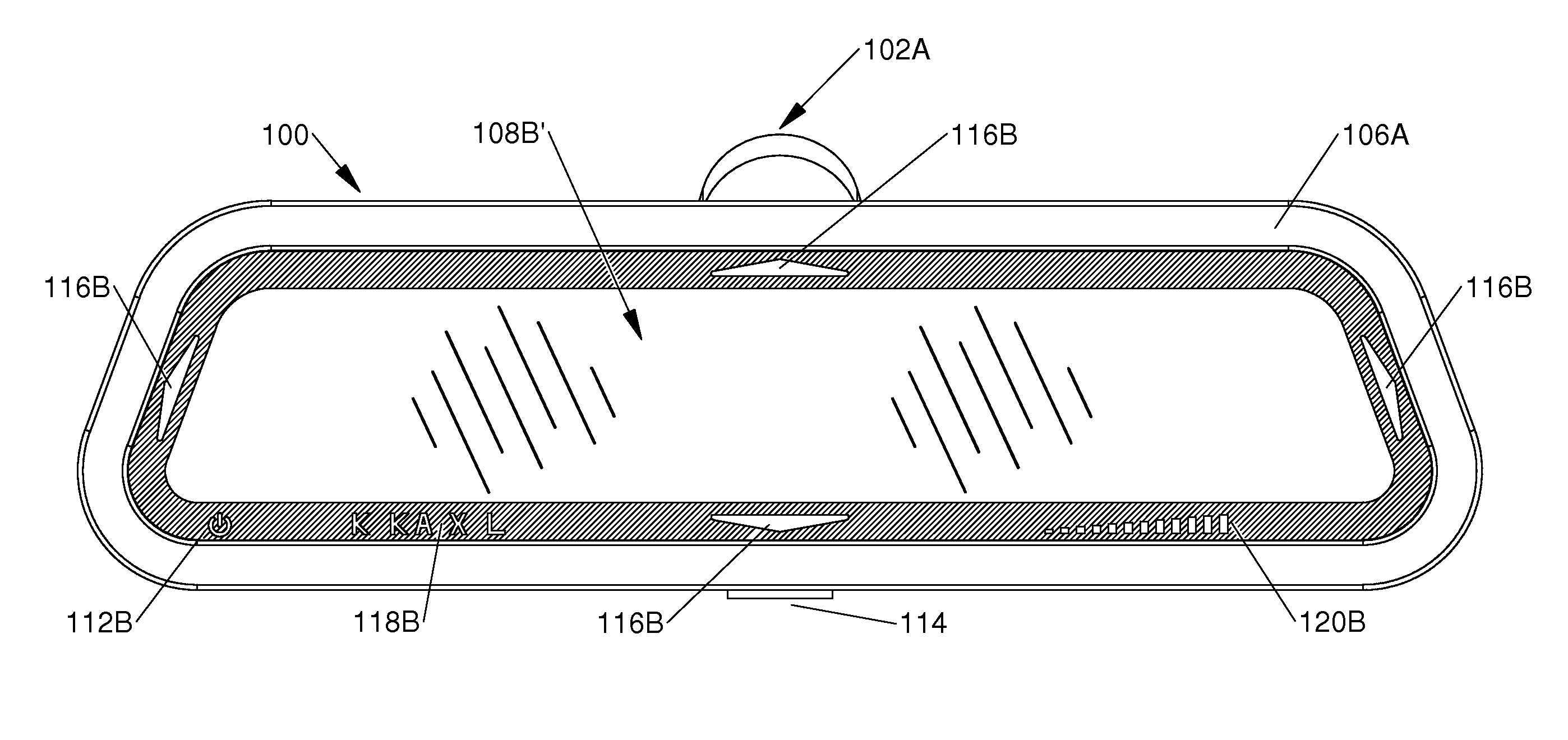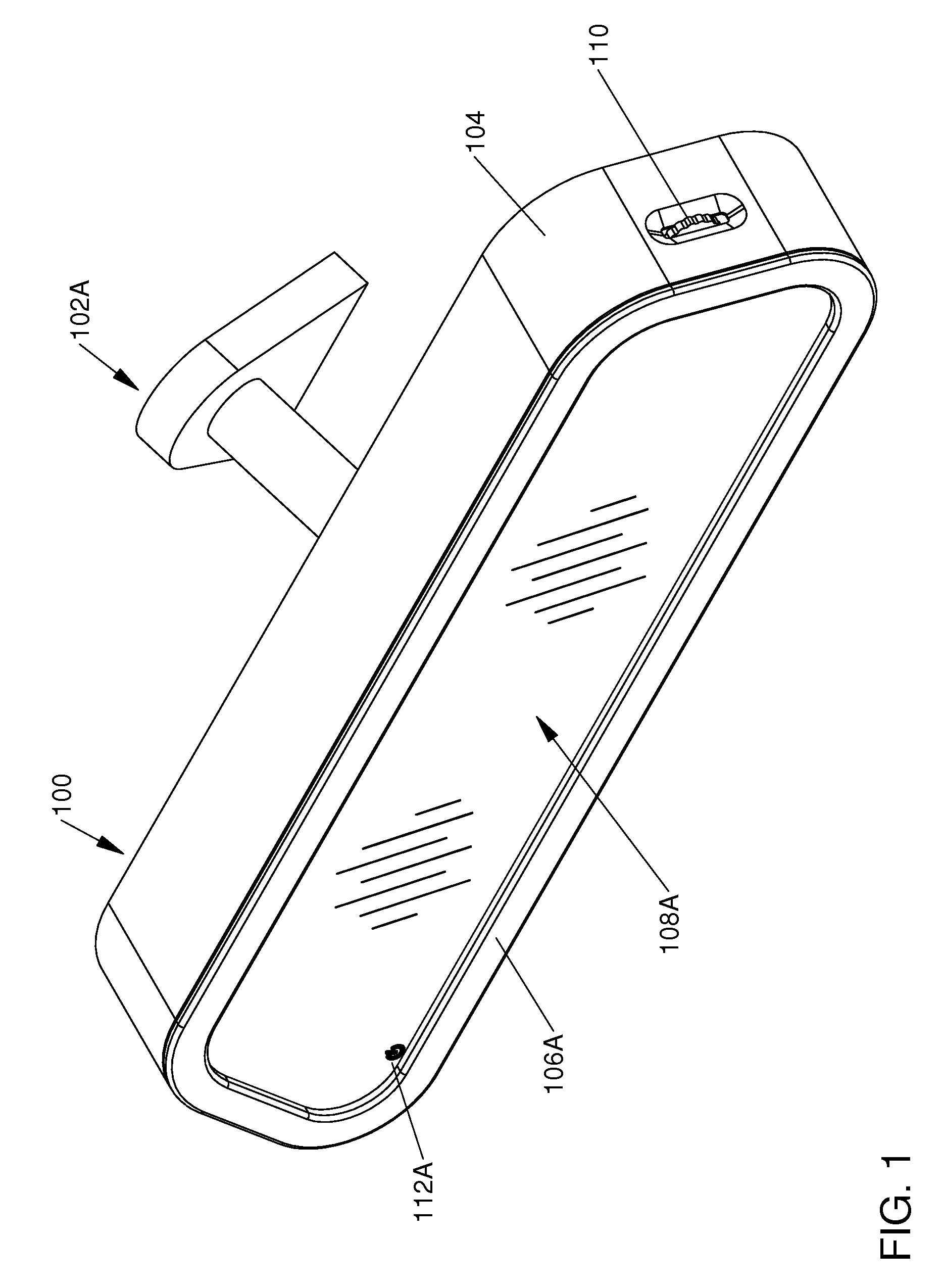Rearview mirror assembly encompassing a radar detector and/or laser detector
a technology of laser detectors and rearview mirrors, applied in the direction of machine supports, instruments, other domestic objects, etc., can solve the problems of reducing the ability of the windshield to adhere securely, and affecting the use of radar detectors
- Summary
- Abstract
- Description
- Claims
- Application Information
AI Technical Summary
Benefits of technology
Problems solved by technology
Method used
Image
Examples
first embodiment
b>4 and 11-12
[0040]One embodiment of the rearview mirror assembly is illustrated in FIG. 1 (front perspective view), FIG. 2 (front view in standby mode), FIG. 3 (front view with illuminated indicators), and FIG. 4 (rear view).
[0041]FIG. 1 shows a front perspective view of rearview mirror assembly 100, and windshield mount assembly 102A that enables rearview mirror assembly 100 to attach to a vehicle windshield. The mirror assembly 100 consists of a housing 104 and a bezel 106A, which supports mirror glass assembly 108A. Mirror assembly 100 accommodates multi-function roller / push button 110 and multi-function push button 114 (shown in FIG. 2). Internal to mirror assembly 100 is a PCB assembly 136 which contains controlling electronics for the detection and notification of radar and laser signals. Functions provided by the PCB assembly 136 include but are not limited to illumination of indicators via LEDs, audible notification via speaker, user inputs. Multi-function roller / push butto...
second embodiment
FIGS. 5-6—Second Embodiment
[0050]The second embodiment is differentiated by the masked perimeter of the mirror glass assembly 108A.
[0051]FIG. 5 consists of rear view mirror assembly 100 in standby mode and shows the presence of windshield mount assembly 102A, bezel 106A, multi-function push button 114, and mirror glass assembly 108A. Power indicator 112B is illuminated to indicate power to the device and standby mode.
[0052]FIG. 6 consists of rear view mirror assembly 100 with all available indicators illuminated. One example when this occurs is during the startup sequence after the device has been powered. Also shown are windshield mount assembly 102A, bezel 106A, multi-function push button 114, and mirror glass assembly 108B′. Illuminated indicators include power indicator 112B, directional indicators 116B, signal type indicator 118B, and intensity indicator 120B are visible in mirror glass assembly 108B′.
third embodiment
FIGS. 7-8—Third Embodiment
[0053]The third embodiment is differentiated by the etched indicators of the mirror glass assembly 108C.
[0054]FIG. 7 consists of rear view mirror assembly 100 when in standby mode. Also shown are windshield mount assembly 102A, bezel 106A, multi-function push button 114, and mirror glass assembly 108C. Power indicator 112C is illuminated indicating power to the device and standby mode. Directional indicators 116C, signal type indicator 118C, and intensity indicator 120C are visible in mirror glass assembly 108C but are not illuminated.
[0055]FIG. 8 consists of rear view mirror assembly 100 with all available indicators illuminated. One example when this occurs is during the startup sequence after the device has been powered. Also shown are windshield mount assembly 102A, bezel 106A, multi-function push button 114, and mirror glass assembly 108C′. Illuminated indicators include power indicator 112C, directional indicators 116C′, signal type indicator 118C′, a...
PUM
 Login to View More
Login to View More Abstract
Description
Claims
Application Information
 Login to View More
Login to View More - R&D
- Intellectual Property
- Life Sciences
- Materials
- Tech Scout
- Unparalleled Data Quality
- Higher Quality Content
- 60% Fewer Hallucinations
Browse by: Latest US Patents, China's latest patents, Technical Efficacy Thesaurus, Application Domain, Technology Topic, Popular Technical Reports.
© 2025 PatSnap. All rights reserved.Legal|Privacy policy|Modern Slavery Act Transparency Statement|Sitemap|About US| Contact US: help@patsnap.com



